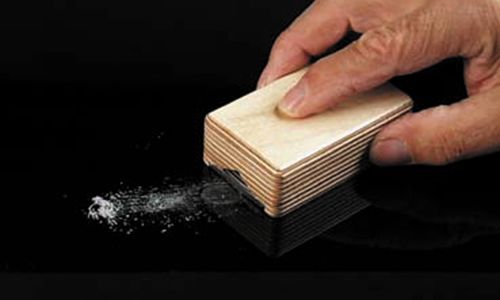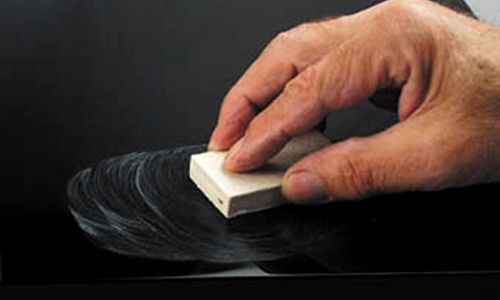
Step 1:
Remove any loose material, angling transitions with the Edge Planer, then sand with 800-grit sand paper. Clean the area. Pre-colour light spots with Touch-Up Dye.
Remove any loose material, angling transitions with the Edge Planer, then sand with 800-grit sand paper. Clean the area. Pre-colour light spots with Touch-Up Dye.

Step 2:
Dip a wooden spatula into mixed varnish* and carefully fill the hole drop by drop. For precise instructions on varnish mixing, refer to the provided instructions. Fill the damaged area well. The matt paraffin film that forms must no longer be touched. Allow approximately 60 minutes for curing, or 12-24 hours for coloured polyester repairs or precise work like on pianos.
Dip a wooden spatula into mixed varnish* and carefully fill the hole drop by drop. For precise instructions on varnish mixing, refer to the provided instructions. Fill the damaged area well. The matt paraffin film that forms must no longer be touched. Allow approximately 60 minutes for curing, or 12-24 hours for coloured polyester repairs or precise work like on pianos.
Used Products:
Polyester Filling Lacquer Set
Polyester Filling Lacquer Set

Step 3:
Carefully remove excess polyester using the Special Scraper or the Metal Planer.
Carefully remove excess polyester using the Special Scraper or the Metal Planer.

Step 4:
Wet-sand the surface using Sanding Liquid and progressively finer Sandpaper, “wet” and Micro Sanding Paper. Start with the coarsest grit and clean the surface between each sanding stage.
Wet-sand the surface using Sanding Liquid and progressively finer Sandpaper, “wet” and Micro Sanding Paper. Start with the coarsest grit and clean the surface between each sanding stage.

Step 5:
Apply Polishing Paste, “fine” to the Felt Pad, thoroughly polishing the remaining fine sanding marks. Ensure the paste remains damp to prevent clumping and scuffing. Use a paper wipe between polishing passes to check results.
Apply Polishing Paste, “fine” to the Felt Pad, thoroughly polishing the remaining fine sanding marks. Ensure the paste remains damp to prevent clumping and scuffing. Use a paper wipe between polishing passes to check results.

Step 6:
Done!
Done!
Before

After

